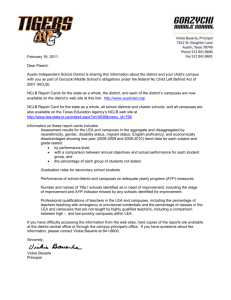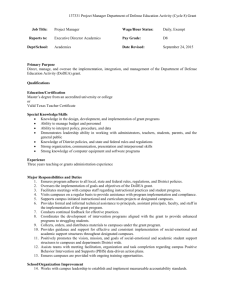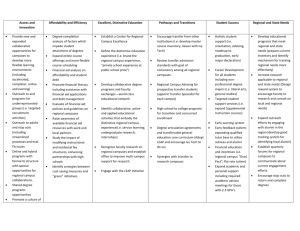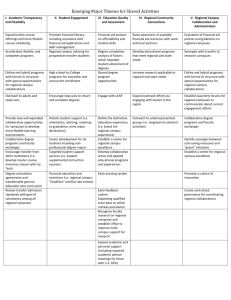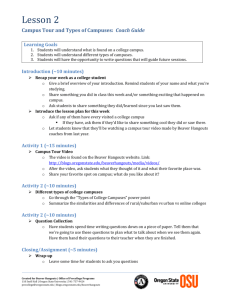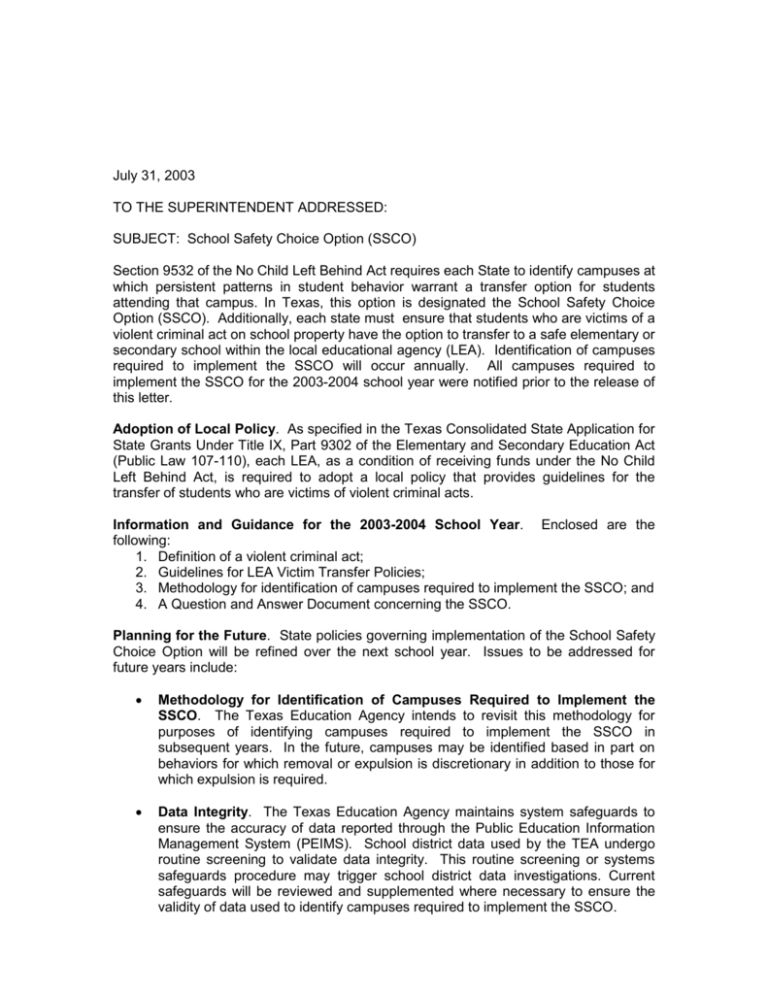
July 31, 2003
TO THE SUPERINTENDENT ADDRESSED:
SUBJECT: School Safety Choice Option (SSCO)
Section 9532 of the No Child Left Behind Act requires each State to identify campuses at
which persistent patterns in student behavior warrant a transfer option for students
attending that campus. In Texas, this option is designated the School Safety Choice
Option (SSCO). Additionally, each state must ensure that students who are victims of a
violent criminal act on school property have the option to transfer to a safe elementary or
secondary school within the local educational agency (LEA). Identification of campuses
required to implement the SSCO will occur annually. All campuses required to
implement the SSCO for the 2003-2004 school year were notified prior to the release of
this letter.
Adoption of Local Policy. As specified in the Texas Consolidated State Application for
State Grants Under Title IX, Part 9302 of the Elementary and Secondary Education Act
(Public Law 107-110), each LEA, as a condition of receiving funds under the No Child
Left Behind Act, is required to adopt a local policy that provides guidelines for the
transfer of students who are victims of violent criminal acts.
Information and Guidance for the 2003-2004 School Year. Enclosed are the
following:
1. Definition of a violent criminal act;
2. Guidelines for LEA Victim Transfer Policies;
3. Methodology for identification of campuses required to implement the SSCO; and
4. A Question and Answer Document concerning the SSCO.
Planning for the Future. State policies governing implementation of the School Safety
Choice Option will be refined over the next school year. Issues to be addressed for
future years include:
Methodology for Identification of Campuses Required to Implement the
SSCO. The Texas Education Agency intends to revisit this methodology for
purposes of identifying campuses required to implement the SSCO in
subsequent years. In the future, campuses may be identified based in part on
behaviors for which removal or expulsion is discretionary in addition to those for
which expulsion is required.
Data Integrity. The Texas Education Agency maintains system safeguards to
ensure the accuracy of data reported through the Public Education Information
Management System (PEIMS). School district data used by the TEA undergo
routine screening to validate data integrity. This routine screening or systems
safeguards procedure may trigger school district data investigations. Current
safeguards will be reviewed and supplemented where necessary to ensure the
validity of data used to identify campuses required to implement the SSCO.
Schedule. The schedule for identification of campuses required to implement
the SSCO will be accelerated in future years. It is anticipated that identification
of campuses will occur during late spring and early summer and that campuses
identified will be notified no later than July 1st.
Early Warning Notice. The Texas Education Agency will consider issuing
warning notices in the future to campuses that have not been identified but are
approaching the threshold for identification as a campus required to implement
the SSCO.
Data Collection. PEIMS data standards must be refined to ensure that
disciplinary action reason codes reflect uniform state standards with respect to
reporting of knife possession and offenses occurring at charter schools.
o
Knives. The methodology used for identification of campuses required to
implement the SSCO for the 2002-2003 school year excludes
consideration of data reporting student possession of knives (PEIMS
Disciplinary Action Reason Code 12). Exclusion of these data in no way
reflects a policy judgment about the danger posed by knives. Rather,
reports of knife possession were excluded from consideration because
current data standards permit significant disparity in the types of conduct
that may be reported by school districts as “possession of an illegal knife.”
The methodology for identification of campuses subject to the SSCO
must be based on standardized data. Data collection requirements will
be revised to ensure consistency in reporting so that knife offenses may
be included in this analysis in future years. [Note: Reports of possession
of switchblade knives were included in the analysis because these knives
are reported in a standard way under the Prohibited Weapon category.]
o
Charter Schools. Current data standards require open-enrollment charter
schools to report only a small subset of the data used to identify
campuses required to implement the SSCO for the 2003-2004 school
year. Thus, charter schools were excluded from the analysis conducted
for this purpose. Data collection standards applicable to charter schools
will be reconsidered in view of the state’s obligation under federal law to
identify campuses required to implement the SSCO.
School officials are encouraged to review current-year PEIMS data to identify trends that
indicate possible identification as a campus required to implement the SSCO in future
years.
If you have questions regarding this issue, please contact the Division of Safe Schools
at 512-463-9982.
Sincerely,
Robert Scott
Chief Deputy Commissioner
Victims of Violent Criminal Acts
A student who becomes a victim on campus of one of the violent criminal acts listed
below is entitled to transfer to another grade appropriate campus.
Note: The Texas Education Agency has requested guidance from the U.S.
Department of Education regarding extension of the transfer option to siblings of
victims of violent criminal acts when the sibling would otherwise be required to
attend the campus on which the violent criminal act occurred. Districts will be
notified when guidance is received.
o
Attempted murder under Texas Penal Code Sections 19.02, 19.03, and 15.01
(reported under PEIMS 425 Action Reason Code 17) ;
o
Indecency with a child under Texas Penal Code Section 21.11 (reported under
PEIMS 425 Action Reason Code 18);
o
Aggravated kidnapping under Texas Penal Code Section 20.04 (reported
under PEIMS 425 Action Reason Code 19)
o
Assault on student under Texas Penal Code Section 22.01(a)(1) (reported
under PEIMS 425 Action Reason Code 28);
o
Aggravated assault on student under Texas Penal Code Section 22.02
(reported under PEIMS 425 Action Reason Code 30); and
o
Sexual assault or aggravated sexual assault against a student under Texas
Penal Code Sections 22.011 and 22.021 (reported under PEIMS 425 Action
Reason Code 32).
Guidelines for LEA Victim Transfer Policies
Each district and charter school must develop a local policy to guide transfers for
students who are victims of a violent criminal act, whether or not they are located on a
campus required to implement the School Safety Choice Option. The policy must
include the following:
a. Timelines and procedures under which parents may request transfers.
b. Timelines for processing and approving transfer requests.
c. Duration for which a transfer is approved and procedures for renewal of a
transfer.
d. Collection and maintenance of victim data information, e.g., date the
incident occurred, incident number, and identity of perpetrator.
If the district does not have another public grade-appropriate campus, the district is
encouraged to join into an agreement with a neighboring district to accept transfers.
Methodology for Identification of Campuses
Required to Implement the School Safety Choice Option
Pursuant to the requirements of NCLB, Texas has developed a definition and methodology for
identification of campuses required to implement the School Safety Choice Option (SSCO). A
campus will be required to implement the SSCO if it meets the following criteria:
The campus is coded as a Regular Instructional Campus in AskTED; and
The campus has reported to PEIMS (425 Record) three (3) or more selected mandatory
expulsion incidents per 1000 students in each of three consecutive years.
TEA will use the following mandatory expulsion incidents self-reported on a campus’s PEIMS 425
Record of Incidents as the basis of determination. All incidents related to a continuation action from
a prior school year or district are omitted from this formula.
Incident Chart
Discipline
Description of Behavior
Action Reason
Code
Mandatory Expellable Incidents Included in Definition
11
Used, exhibited, or possessed firearm
13
Used, exhibited, or possessed club
14
Used, exhibited, or possessed weapon
16
Arson
17
Murder, attempted murder
18
Indecency with a child
19
Aggravated kidnapping
29
Aggravated assault on school employee
30
Aggravated assault on student
31
Sexual assault or aggravated sexual assault on school
employee
32
Sexual assault or aggravated sexual assault on student
36
Felony controlled substance
37
Felony alcohol violation
Required
Implement
SSCO
to
Three (3) or
more per 1000
students
per
year in each of
three
(3)
consecutive
years
All regular instructional campuses that have at least one of the above mandatory expulsion
incidents in any of the most recent three years will be included in the pool of campuses analyzed.
Each incident is counted once, regardless of the number of students involved.
Formula for Identifying Campuses Required to Implement the SSCO
Step 1: Calculate the number of selected incidents per year for the three most recent
consecutive years (1999-2000, 2000-2001, and 2001-2002).
Step 2: Divide the cumulative enrollment of each campus by 1000 (Adjustment Factor for
Campus Size).
Step 3: Divide the number of incidents for each year by the Adjustment Factor for Campus
Size.
Step 4: Identify campuses with three (3) or more incidents (using the Adjustment Factor for
Campus Size) across the three most recent years.
Step 5: Campuses that are at or above three (3) incidents per 1000 students across the
three school years are identified as required to implement the SSCO.
School Safety Choice Option Question & Answer Document
Based on Section “C” of Draft USDE Guidance
1. What must an LEA do when one or more of its campuses are required to
implement the School Safety Choice Option (SSCO)?
At a minimum, an LEA that has one or more schools required to implement the
SSCO must, in a timely manner:
(1) Notify parents of each student attending the school that the state has
required the campus to implement the SSCO;
(2) Offer students the opportunity to transfer to a safe public school,
including a safe public charter school, within the LEA; and
(3) For those students who accept the offer, complete the transfer.
In addition, an LEA should also:
(4) Develop a corrective action plan; and
(5) Implement that plan in a timely manner.
Parental notification regarding the status of the school and the offer to transfer
students may be made simultaneously.
2. What is “timely implementation” of these steps?
Although “timely implementation” depends on the specific circumstances within
the LEA, generally, an example of timely notification to parents or guardians is
within ten school days from the time that the LEA learns that the school has been
required to implement the SSCO.
An example of timely development of a corrective action plan and the offer to
students of the opportunity to transfer generally is within twenty school days from
the time that the LEA learns that the school has been required to implement the
SSCO.
Transfers of students generally should occur within 30 school days.
3.
Should the LEA submit its corrective action plan to the SEA for
approval?
Yes. In addition, after approving an LEA’s corrective action plan, the SEA should
provide technical assistance as the plan is implemented and should monitor the
LEA’s timely completion of the approved plan.
4. What types of corrective action may be taken?
Corrective action should be based on an analysis of the problems faced by the
school and address the issues that resulted in the school being required to
implement the SSCO. Some examples of corrective action include hiring
additional personnel to supervise students in common areas, increased
instructional activities in areas such as conflict resolution, working with law
enforcement officials to identify and eliminate gang-related activities, in-service
training of teachers and administrators concerning consistent enforcement of
school discipline policies, limiting access to campuses, and hiring of security
personnel or purchase of security equipment.
5.
What resources are available to help schools implement corrective
action and help cover the costs of transportation? (Questions C-5 and
E-5)
Consistent with applicable requirements such as those contained in the Safe and
Drug-Free Schools and Communities Act “Principles of Effectiveness,” Safe and
Drug-Free Schools and Communities Act State Grant program funds may be
used to implement planned corrective actions [section 4115]. LEAs may also
consider using the flexibility provided under Section 6123(b) of the ESEA, which
provides for the transfer, under certain circumstances, of funds from one ESEA
program to another. Detailed information concerning the permissible uses of
transferred funds will soon be available in nonregulatory guidance from the
United States Department of Education which will be released later this summer.
State and local resources may also be used to help schools implement corrective
action.
Section 9532 of the No Child Left Behind Act does not authorize resources
specifically to help cover transportation costs when a student elects to transfer to
a safe, grade-appropriate public school. However, under certain circumstances
Federal funds may be used. For example, Title IV, Part A funds may be used to
establish safe zones of passage to and from school to ensure that students travel
safely on their way to school and on their way home [section 4115(b)(2)(E)(v)].
In addition, Title V, Part A funds may be used to help cover costs such as tuition
or transportation related to transfers for this purpose or expansion of public
school choice [sections 5121(8) and 5131(12) and (25)].
In addition, LEAs are encouraged to work with local victims’ assistance units to
determine if they have funds available if the student who is transferring has been
a victim of a violent criminal incident.
6. What does the LEA do when corrective action has been completed?
Under the SSCO policy, a school will be notified when it has successfully
completed its corrective actions. The campus will be reassessed in the following
year using the agreed upon criteria for identification of campuses required to
implement the SSCO.
7. Must all students attending a campus required to implement the SSCO
be offered the opportunity to transfer?
Yes.
8. Are students at campuses required to implement the SSCO required to
transfer to another school in the LEA?
No. Students are not required to transfer, but must be offered the opportunity to
do so.
9. If a student attending a public school campus required to implement the
SSCO elects to transfer to a safe public school, how is the school
selected?
To the extent possible, LEAs should allow transferring students to transfer to a
school that is making adequate yearly progress and has not been identified as
being in school improvement, corrective action, or restructuring. The LEA is
encouraged to take into account the needs and preferences of the affected
students and parents.
10. If a student elects to transfer to a safe public school, is the transfer
permanent or temporary?
The transfers may be temporary or permanent, but must be in effect as long as
the student’s original school is required to implement the SSCO. In making the
determination of whether the transfer should be temporary or permanent, LEAs
should consider the educational needs of the student, as well as other factors
affecting the student’s ability to succeed if returned to the transferring school.
For example, an LEA may want to consider allowing a student to complete his or
her education through the highest grade level at the receiving school.
11.
What if there is not another school in the LEA for the transferring
student(s)?
LEAs are encouraged, but not required, to explore other appropriate options such
as an agreement with a neighboring LEA to accept transfer students.
Final non-regulatory guidance on Section 9532 of the No Child Left Behind Act should
be released by the U.S. Department of Education by August 11, 2003. Adjustments may
be made to the School Safety Choice Option policy after receipt of the final nonregulatory guidance.

